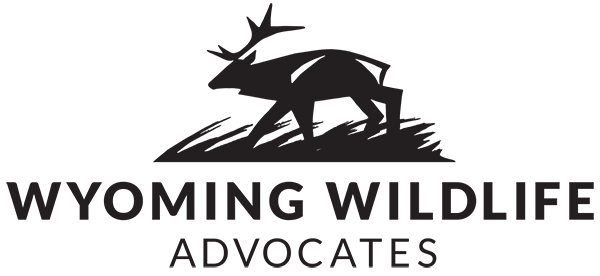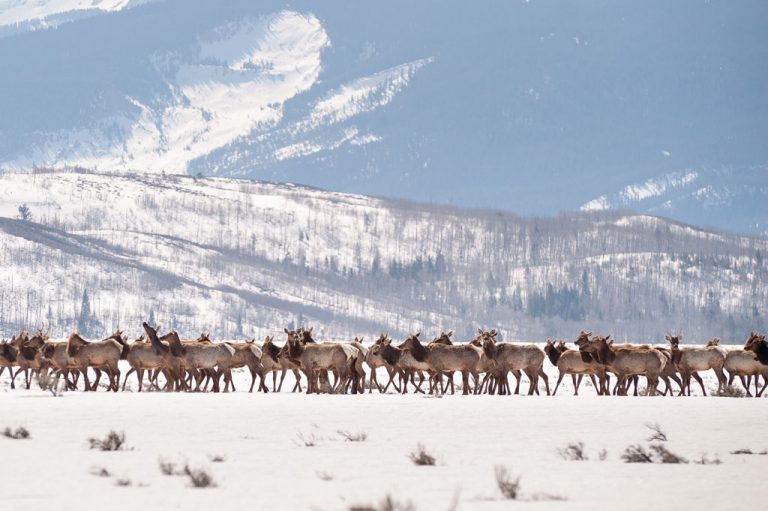Groups sue feds over “recipe for disaster” for Jackson elk herd.
by Melissa Thomasma/Planet Jackson Hole | JUNE 6, 2017
Four conservation groups that fear for the health of Jackson’s elk herd filed a lawsuit on Monday against the Forest Service over management of the Alkali Creek feedground.
“The high-risk feedlot, run by the Wyoming Game and Fish Department, baits and unnaturally concentrates wild Jackson elk in ways that are dangerously unhealthy,” reads a June 5 press release issued by Wyoming Wildlife Advocates, Western Watersheds Project, the Sierra Club, and Gallatin Wildlife Association.
“When—not ‘if’—chronic wasting disease arrives at Alkali Creek feedground, it may decimate the Jackson herd within the forest, on the National Elk Refuge, and in other portions of the Greater Yellowstone Ecosystem,” said Jonathan Ratner, Wyoming Director of Western Watersheds Project. “Elk feedgrounds are a recipe for disaster.”
Indeed, supplemental feeding for elk throughout the winter not only artificially bolsters herd size, it also creates an environment through which disease can spread like wildfire.
Chronic wasting disease—the prion disease that strikes and slowly kills cervids by decimating their brains—is expanding rapidly across Wyoming, and drawing nearer to Jackson’s iconic elk herd. Its impacts on the local elk population are unclear as of yet, but many—including the case’s plaintiffs—fear they will be serious and long-lasting.
In the hopes of mitigating the disease, the four regional environmental nonprofits have teamed up to take the U.S. Forest Service and the Department of Agriculture to court over continued elk feeding.
The 91-acre Alkali Creek Feedground is situated in the Bridger-Teton National Forest along the Gros Ventre River, abutting the nearby wilderness. The feedground rests squarely between two noteworthy zones: the part of the state already infected with CWD and the non-infected National Elk Refuge, home to the nation’s largest and perhaps most culturally and economically significant elk herd.
As of now, Teton County is one of two Wyoming counties that is free of the disease, but conservationists fear that Alkali Feedground might be the route via which it could arrive. A CWD-positive deer was found a mere 40 miles to the east, and elk are known to frequently traverse the small distance between Alkali and the National Elk Refuge. In other words, if CWD makes it to Alkali Creek, it’s extremely likely to infect the Jackson herd quickly.
“The feedgrounds disrupt the elk’s natural behavior to forage on native habitats, and instead create an artificial environment that is ripe for spreading disease,” Glenn Hockett, volunteer president of the Gallatin Wildlife Association, said. “The elk in this region are connected to Yellowstone Park and Montana’s elk herds. Hunters and wildlife watchers depend on these elk. The entire multi-billion dollar wildlife-based economy of the region is at risk from diseases perpetuated from the many elk feedgrounds on public lands.”
The plaintiffs point out that the 2007 Final Bison and Elk Management Plan and Environmental Impact Statement included plans to phase out elk feeding precisely because of the potentially lethal impacts on herds.
“In the … statement, issued jointly by those two agencies, the [National Park Service] and the [Fish and Wildlife Service] committed to ending the practice of artificial feeding based on the widely accepted view in the scientific community that the indefinite operation of large feedgrounds constitutes an unacceptable risk to the elk herd, other wildlife, and the surrounding environment.”
Now, the conservation groups argue, authorizing continued feeding on the Alkali Creek Feedground is in violation of this commitment.
What’s more, the groups contend that the Forest Service failed to fully explore reasonable management alternatives, account for the complex ecological impacts of feeding and did not sufficiently weigh public input.
Western Watersheds Project brought a similar case against the Forest Service in 2015, citing concerns about renewal of other regional feedgrounds including Green River Lakes, Dog Creek, Fall Creek, and Fish Creek. According to the organization’s executive director, Erik Molvar, that case was voluntarily dismissed in order to place renewed focus on Alkali Creek.
For now, federal officials’ lips are sealed. Bridger-Teton public affairs officer Mary Cernicek was unable to comment on the case, since it’s under current litigation. Renny MacKay, communications director for the Wyoming Game and Fish Department, confirmed that the agency had received a copy of the complaint, but declined to comment.
“The Forest Service must consider and implement healthier alternatives for managing America’s iconic wildlife herds,” said Roger Hayden, executive director of Wyoming Wildlife Advocates. “Allowing wild elk to roam free in natural abundance with predators keeping herds healthy is the most sustainable paradigm for the future.”

